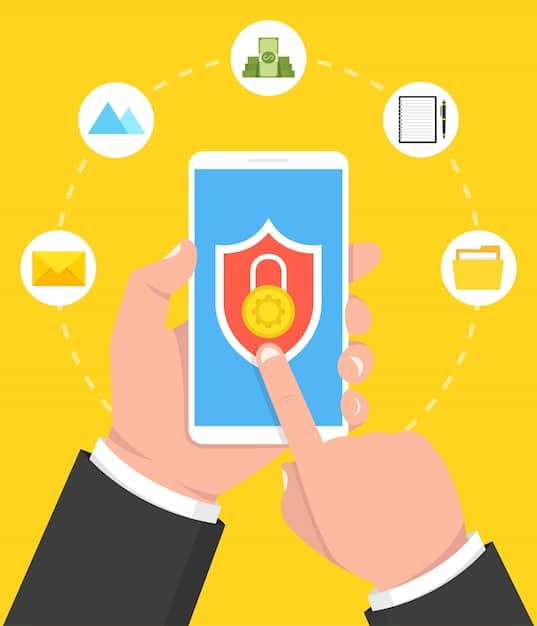Mobile Device Security: A Comprehensive Cybersecurity Guide

Mobile device security is crucial for safeguarding company data, requiring a comprehensive approach that includes policies, employee training, and robust security measures to protect against evolving cyber threats.
In today’s interconnected world, mobile devices have become indispensable tools for employees, enabling productivity and collaboration on the go. However, this convenience comes with significant cybersecurity risks. This cybersecurity guide: mobile device security: protecting company data on employee devices is essential for businesses looking to secure their sensitive information.
Understanding the Risks of Mobile Device Use in the Workplace
Mobile devices, while enhancing productivity, also introduce vulnerabilities that cybercriminals can exploit. Understanding these risks is the first step in building a robust mobile device security strategy. Let’s delve into some common threats and areas of concern.
The increasing reliance on smartphones and tablets for work-related tasks creates numerous entry points for cyberattacks. From unsecured Wi-Fi networks to phishing scams targeting mobile users, the challenges are constantly evolving.
Common Mobile Security Threats
Several types of attacks can compromise the security of mobile devices. Being aware of these threats enables organizations to proactively implement preventive measures.
- Malware: Malicious software designed to infiltrate and damage mobile devices, often disguised as legitimate apps.
- Phishing: Deceptive attempts to trick users into revealing sensitive information, such as passwords or financial details, via email, SMS, or social media.
- Unsecured Wi-Fi: Connecting to public Wi-Fi networks without proper security protocols can expose data to eavesdropping and interception.
- Data Leakage: Accidental or intentional exposure of sensitive data stored on or accessed through mobile devices.
Furthermore, the BYOD (Bring Your Own Device) trend presents additional complexities, as personal devices may lack the security controls found in corporate-owned equipment.
In summary, recognizing these threats is crucial for developing effective **cybersecurity guide: mobile device security: protecting company data on employee devices** strategies.
Creating a Comprehensive Mobile Device Security Policy
A well-defined mobile device security policy is the cornerstone of protecting company data. This policy should outline clear guidelines and expectations for employees using mobile devices for work. Here’s how to craft an effective policy.
A security policy provides a framework for managing mobile device usage and mitigating potential risks. It should be comprehensive yet easily understandable.
Key Elements of a Mobile Device Security Policy
Your policy should address various aspects of mobile device usage, ensuring a holistic approach to security.
- Acceptable Use: Define what constitutes acceptable and unacceptable use of mobile devices for work purposes.
- Password Requirements: Mandate strong, unique passwords or passcodes for all devices.
- Data Encryption: Require encryption of sensitive data stored on mobile devices.
- App Installation Guidelines: Set rules for installing and using apps, including restrictions on installing apps from untrusted sources.

Regularly reviewing and updating the policy is essential to keep pace with evolving threats and technological advancements. Also, ensure the policy is communicated effectively to all employees.
In brief, a comprehensive policy is a key component of a successful **cybersecurity guide: mobile device security: protecting company data on employee devices** plan.
Implementing Strong Authentication and Access Controls
Authentication and access controls are critical for verifying user identities and limiting access to sensitive data. Strong authentication methods can significantly reduce the risk of unauthorized access. Let’s explore some robust measures that organizations can employ.
Inadequate authentication and access controls can leave company data vulnerable to breaches. Implementing stringent measures is paramount.
Multi-Factor Authentication (MFA)
MFA adds an extra layer of security by requiring users to provide multiple forms of verification before gaining access to resources.
MFA can involve a combination of something the user knows (password), something the user has (security token), and something the user is (biometric data).
Role-Based Access Control (RBAC)
RBAC restricts access to data and resources based on the user’s role within the organization. This ensures that employees only have access to the information they need to perform their duties.
Employing both MFA and RBAC provides complementary security benefits. MFA strengthens identity verification, while RBAC minimizes the potential impact of a compromised account.
Overall, implementing strong authentication and access controls will increase effectiveness of **cybersecurity guide: mobile device security: protecting company data on employee devices** strategies.
Securing Mobile Devices with Mobile Device Management (MDM)
Mobile Device Management (MDM) solutions provide centralized control and security over mobile devices used within the organization. MDM enables administrators to enforce security policies, deploy applications, and remotely manage devices. Let’s explore the benefits of utilizing MDM.
MDM solutions offer a comprehensive suite of features designed to enhance mobile device security and streamline management.
Key Features of MDM
MDM solutions typically offer a range of features, including:
- Remote Device Management: Remotely lock, wipe, or locate devices in case of loss or theft.
- Policy Enforcement: Enforce security policies, such as password requirements and data encryption.
- App Management: Deploy approved apps and restrict the installation of unauthorized apps.
- Compliance Monitoring: Monitor device compliance with security policies and generate reports.
MDM not only enhances security but also simplifies device management, reducing the burden on IT staff.
In conclusion, integrating MDM into **cybersecurity guide: mobile device security: protecting company data on employee devices** infrastructure enhances security.
Educating Employees About Mobile Security Best Practices
Employee awareness is a critical component of mobile device security. Educating employees about common threats and best practices can significantly reduce the risk of human error. Consider these training elements:
Even the most robust security measures can be undermined by human error. Training is key for creating a security-conscious workforce.
Training Topics
Effective training programs should cover the following topics:
- Phishing Awareness: Teach employees how to recognize and avoid phishing attacks.
- Secure Wi-Fi Usage: Educate employees about the risks of using unsecured Wi-Fi networks and the importance of using VPNs.
- Data Security: Provide guidelines for handling sensitive data on mobile devices.
- Password Security: Emphasize the importance of using strong, unique passwords.

Regular security awareness training, coupled with ongoing reminders and updates, reinforces best practices and keeps employees vigilant.
In short, empowering employees is pivotal for **cybersecurity guide: mobile device security: protecting company data on employee devices** goals.
Regularly Monitoring and Updating Mobile Devices
Continuous monitoring and timely software updates are essential for maintaining the security of mobile devices. Regular monitoring helps identify and respond to potential threats. Updates address security vulnerabilities and improve device performance. Read about the importance of these steps.
Failing to monitor devices and apply updates can leave them vulnerable to known exploits.
Monitoring and Update Strategies
Best to follow these strategies to keep mobile devices secure:
- Security Monitoring: Implement tools and processes for monitoring mobile devices for suspicious activity.
- Software Updates: Ensure that devices are running the latest software versions and security patches.
- Vulnerability Scanning: Conduct regular vulnerability scans to identify potential weaknesses.
By proactively monitoring devices and applying updates, organizations can minimize their exposure to cyber threats.
Therefore, constant vigilance is crucial for reinforcing **cybersecurity guide: mobile device security: protecting company data on employee devices** practices.
| Key Point | Brief Description |
|---|---|
| 🛡️ Security Policy | Outlines guidelines for mobile device use. |
| 🔑 Authentication | Uses MFA and RBAC for secure access. |
| 📱 MDM Solutions | Centralizes control and applies security policies. |
| 👨🏫 Training | Educates staff about threats and best practices. |
Frequently Asked Questions (FAQ)
▼
Mobile device security is crucial to protect sensitive company data from threats like malware, phishing, and data breaches, ensuring operational continuity and maintaining customer trust.
▼
MDM is a solution for managing and securing mobile devices through policies, app deployment, and remote device management, improving overall security while simplifying IT administration.
▼
Educate employees through regular training on phishing awareness, secure Wi-Fi use, data handling, and password security to minimize human error and enhance security protocols.
▼
Key elements include acceptable use guidelines, strong password requirements, data encryption mandates, and procedures for installing and using applications securely on devices.
▼
MFA adds an extra layer of protection, requiring users to provide several verification methods, reducing the risk of unauthorized access to sensitive corporate information from compromised accounts.
Conclusion
Securing company data on employee mobile devices requires a multifaceted approach, incorporating comprehensive security policies, strong authentication methods, mobile device management solutions, employee training, and continuous monitoring. By implementing these strategies, organizations can significantly reduce their risk exposure and maintain the integrity of their data.





